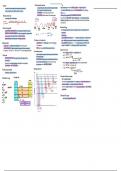Isotopes Electromagnetic spectrum *
• are atoms of the same element that contain the same number of • a range of frequencies that covers all electromagnetic radiation • heat or electricity can be used to EXCITE an electron to a higher energy level
protons & electrons but a different number of neutrons & their respective wavelengths and energy • when electrons ‘fall’ back down they must lose the energy different between 2 energy
• FREQUENCY: how many waves pass per second levels
Relative atomic mass • WAVELENGTH: distance between 2 consecutive peaks • this loss of energy releases ELECTROMAGNETIC ENERGY
• the average mass of all the isotopes
high energy • gives evidence for Bohr’s model of discrete energy levels so an exact amount of energy
new enery length short wavelength
(t high frequency • limitations to this model: assumes electrons are fixed, spherical, only works for hydrogen
total mass (% abundancexmassa) +
BX ......
B) low fre quency
(with 1 electron)
......
~wwGAMT
=
of 100 atoma 100
Electron energy levels
RADIO
WAVES MICRO-INFRARED
VISIBLE UV X-
RAYS
Ionisation Energy
LIGHT
WAVES • IE: the energy required for en electron to escape the atom, or reach the upper limit of
• ELECTRONIC CONFIGURATION: the arrangement of electrons in an atom
3x00 m/s convergence
• PRINCIPAL QUANTUM NUMBER (n): number of energy levels / quantum shells 2
va C = v .
-
C =
ligh ↑
.
of • Layman series
• quantum number decreases the closer the shell to the nucleus speed
• across a PERIOD: IE increases due to —> increase in nuclear charge, decrease in atomic
• quantum number increases the greater the energy of electrons
Continuous vs Line spectrum radius, shielding remains constant, increase in energy needed to remove an electron
Aufbau principle • CONTINUOUS: in the visible region contained all the colours • down a GROUP: IE decreases due to —-> the outermost electron is farther from the
• ground state: most stable electrons configuration, lowest energy amount of the spectrum nucleus, held less tighter and so less energy is required to remove the electron
• AUFBAU PRINCIPLE: filling the subshells of energy with the lowest energy first • LINE: only shows certain fixed frequencies of electrons
• Exceptions; Cr - [Ar] 3d^5, Cu - [Ar] 3d^10 3s^1 (this is energetically favourable Dips in the IE trend
Line emission spectra
• between Beryllium & Boron there is a light decrease in IE
• each line is specific energy value, electrons posses a limited choice
Hund’s rule • Be -
It : 900k5/mol ,
Is'Is
of allocated energies 25
• B
K5/mo is
• SPIN PAIR REPULSION: spin repel each other when they spin in the
800
-It,
=
↳isfurther awayfromede aan
,
• CONVERGENCE: lines get closer towards blue end of spectrum,
same direction
lines converge to higher energy, electrons reach max energy
• electrons have small spinning charges which rotate on their own axis in • between Nitrogen & Ozygen slight decrease in IE, due to spin pair repulsion
• max electrons reach = IONISATION ENERGY
CLOCKWISE or ANTI-CLOCKWISE • N - It, =
1400k5/mol ,
Is 2s"2px'2py' 2px
• O- It 1310h5/mol 132 Is 2 pc2py' 2 pc
Hydrogen spectrum
=
,
Pauli Exclusion principle
-
↳ 2 é = repulsion between them ,
for one e
to be
• an orbital can only hold 2 electrons
makes it easier
A
L
removed
8
7 Successive ionisation energies
Sublevels & energy Periodic table
• IE of an element increases
S-block p-block
i -V
PLN L
IR C • this is because removing an electron from a position ion , attractive forces increase due to
s
↑ *
decrease in shielding & an increase in the proton to electron ratio
BREFeTT
VvV
Joop
~
(IR) • electrons are harder to remove when there is: less spin-pair repulsion, the closer the shell is
to the nucleus
4S (IR)
ENERGY
>
-
n3
4d n
e
-VVVVV
Deducing the IE group
BALMER
i 1
5d (visible)
• were there is the biggest difference in IE
+ n2
no
f block
Y
-
IS
5f
10000000
I
LYMAN
(ru) Shighogy
n
+ 11





